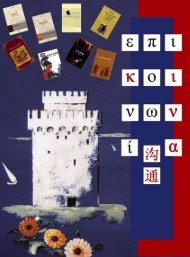Fifth Issue
Fifth Issue
Fifth Issue
You also want an ePaper? Increase the reach of your titles
YUMPU automatically turns print PDFs into web optimized ePapers that Google loves.
human beings, and is used in highly differentiated cultural context as means to express<br />
fear, as someone can be afraid of his own shadow, or live under the shadow of an event,<br />
relations of subjugation to an influence or to a bad memory.<br />
The evolution of Shadow Theater untangles the history of civilizations’<br />
interaction in terms of one of the most symbolic challenges of art: the meanings of<br />
shadow, the effort to capture it in the form of a figure, and to use it as part of a ritual, of<br />
amusement or of satire.<br />
Shadow Theater of the world - The world of Shadow Theater<br />
Replete with myths and controversies, the history of Shadow Theater traces the<br />
origins of this tradition in Asia, either in India, in Indonesia, in Central Asia or in China,<br />
and proposes several options so as to explain how the Shadow Theater spread to the West.<br />
Constantly migrating peoples across Asia and Europe seem to have served as<br />
avenues that linked various shadow traditions, creating a net of interaction which<br />
pervades the cultural norms of different civilizations through the archetypical idea of<br />
shadow and finds its expression in different forms of aesthetic materialization.<br />
Harking back to ancient sources, theories subscribe to origin of Shadow Theater<br />
on the nomadic Turkish tribes of Central Asia, using as evidence religious practices<br />
8






